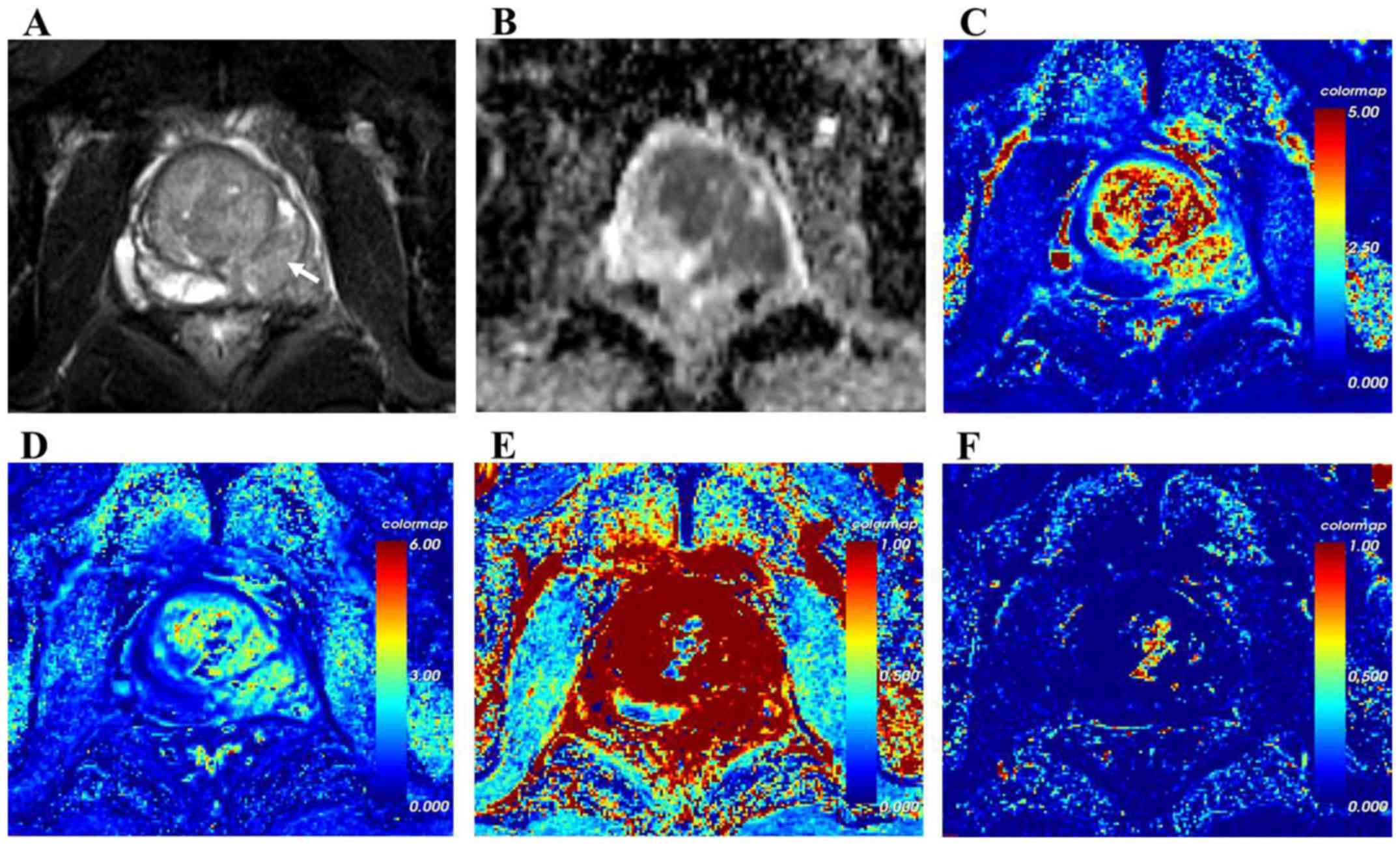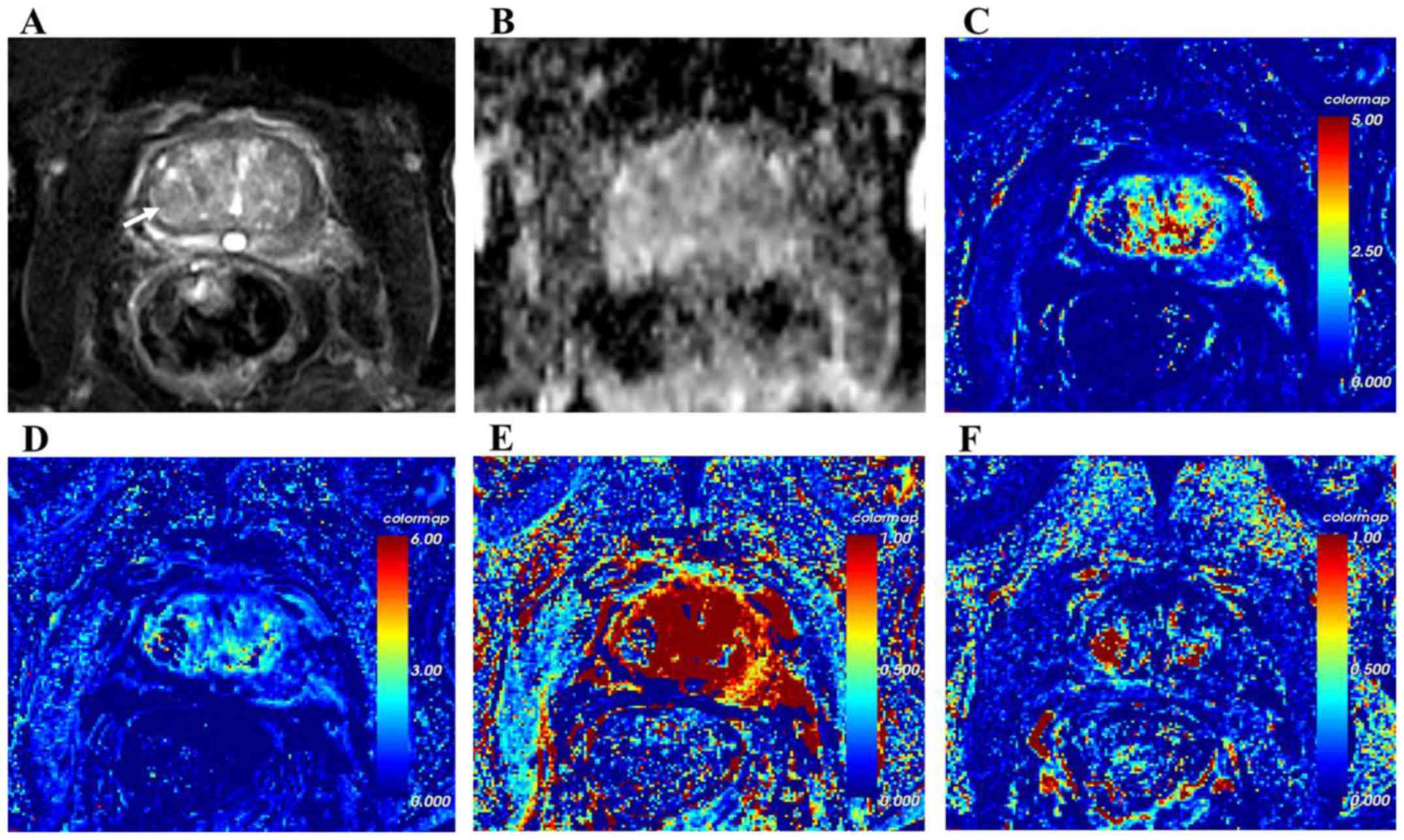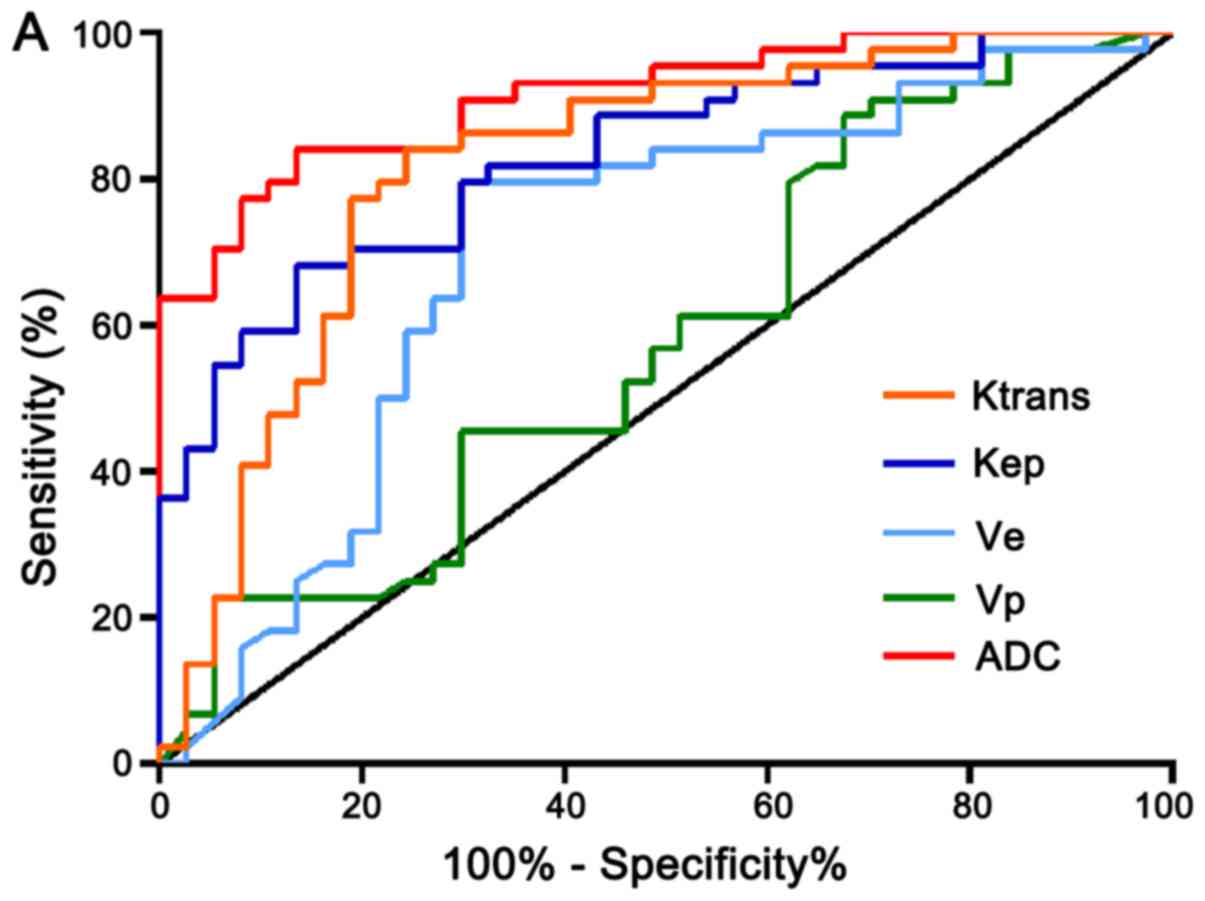|
1
|
Decelle EA and Cheng LL: High-resolution
magic angle spinning 1H MRS in prostate cancer. NMR Biomed.
27:90–99. 2014. View
Article : Google Scholar : PubMed/NCBI
|
|
2
|
Chen W, Zheng R, Baade PD, Zhang S, Zeng
H, Bray F, Jemal A, Yu XQ and He J: Cancer statistics in China,
2015. CA Cancer J Clin. 66:115–132. 2016. View Article : Google Scholar : PubMed/NCBI
|
|
3
|
Hoeks CM, Barentsz JO, Hambrock T, Yakar
D, Somford DM, Heijmink SW, Scheenen TW, Vos PC, Huisman H, van
Oort IM, et al: Prostate cancer: Multiparametric MR imaging for
detection, localization, and staging. Radiology. 261:46–66. 2011.
View Article : Google Scholar : PubMed/NCBI
|
|
4
|
Rosenkrantz AB, Sabach A, Babb JS, Matza
BW, Taneja SS and Deng FM: Prostate cancer: Comparison of dynamic
contrast-enhanced MRI techniques for localization of peripheral
zone tumor. AJR Am J Roentgenol. 201:W471–W478. 2013. View Article : Google Scholar : PubMed/NCBI
|
|
5
|
Manenti G, Squillaci E, Di Roma M, Carlani
M, Mancino S and Simonetti G: In vivo measurement of the apparent
diffusion coefficient in normal and malignant prostatic tissue
using thin-slice echo-planar imaging. Radiol Med. 111:1124–1133.
2006.(In English, Italian). View Article : Google Scholar : PubMed/NCBI
|
|
6
|
Malayeri AA, El Khouli RH, Zaheer A,
Jacobs MA, Corona-Villalobos CP, Kamel IR and Macura KJ: Principles
and applications of diffusion-weighted imaging in cancer detection,
staging, and treatment follow-up. Radiographics. 31:1773–1791.
2011. View Article : Google Scholar : PubMed/NCBI
|
|
7
|
Petrescu A, Mârzan L, Codreanu O and
Niculescu L: Immunohistochemical detection of p53 protein as a
prognostic indicator in prostate carcinoma. Rom J Morphol Embryol.
47:143–146. 2006.PubMed/NCBI
|
|
8
|
Gleason DF and Mellinger GT: Prediction of
prognosis for prostatic adenocarcinoma by combined histological
grading and clinical staging. J Urol. 167:58–64. 1974. View Article : Google Scholar
|
|
9
|
Stark JR, Perner S, Stampfer MJ, Sinnott
JA, Finn S, Eisenstein AS, Ma J, Fiorentino M, Kurth T, Loda M, et
al: Gleason score and lethal prostate cancer: Does 3 + 4 = 4 + 3? J
Clin Oncol. 27:3459–3464. 2009. View Article : Google Scholar : PubMed/NCBI
|
|
10
|
Sourbron SP and Buckley DL: On the scope
and interpretation of the Tofts models for DCE-MRI. Magn Reson Med.
66:735–745. 2011. View Article : Google Scholar : PubMed/NCBI
|
|
11
|
Schlemmer HP, Merkle J, Grobholz R, Jaeger
T, Michel MS, Werner A, Rabe J and van Kaick G: Can pre-operative
contrast-enhanced dynamic MR imaging for prostate cancer predict
microvessel density in prostatectomy specimens? Eur Radiol.
14:309–317. 2004. View Article : Google Scholar : PubMed/NCBI
|
|
12
|
Kozlowski P, Chang SD, Jones EC, Berean
KW, Chen H and Goldenberg SL: Combined diffusion-weighted and
dynamic contrast-enhanced MRI for prostate cancer
diagnosis-correlation with biopsy and histopathology. J Magn Reson
Imaging. 24:108–113. 2006. View Article : Google Scholar : PubMed/NCBI
|
|
13
|
Baur AD, Maxeiner A, Franiel T, Kilic E,
Huppertz A, Schwenke C, Hamm B and Durmus T: Evaluation of the
prostate imaging reporting and data system for the detection of
prostate cancer by the results of targeted biopsy of the prostate.
Invest Radiol. 49:411–420. 2014. View Article : Google Scholar : PubMed/NCBI
|
|
14
|
Hoeks CM, Hambrock T, Yakar D,
Hulsbergen-van de Kaa CA, Feuth T, Witjes JA, Fütterer JJ and
Barentsz JO: Transition zone prostate cancer: Detection and
localization with 3-T multiparametric MR imaging. Radiology.
266:207–217. 2013. View Article : Google Scholar : PubMed/NCBI
|
|
15
|
Nagel KN, Schouten MG, Hambrock T, Litjens
GJ, Hoeks CM, ten Haken B, Barentsz JO and Fütterer JJ:
Differentiation of prostatitis and prostate cancer by using
diffusion-weighted MR imaging and MR-guided biopsy at 3 T.
Radiology. 267:164–172. 2013. View Article : Google Scholar : PubMed/NCBI
|
|
16
|
Itatani R, Namimoto T, Kajihara H,
Katahira K, Kitani K, Hamada Y and Yamashita Y: Triage of low-risk
prostate cancer patients with PSA levels 10 ng/ml or less:
Comparison of apparent diffusion coefficient value and transrectal
ultrasound-guided target biopsy. Am J Roentgenol. 202:1051–1057.
2014. View Article : Google Scholar
|
|
17
|
Katahira K, Takahara T, Kwee TC, Oda S,
Suzuki Y, Morishita S, Kitani K, Hamada Y, Kitaoka M and Yamashita
Y: Ultra-high-b-value diffusion-weighted MR imaging for the
detection of prostate cancer: Evaluation in 201 cases with
histopathological correlation. Eur Radiol. 21:188–196. 2011.
View Article : Google Scholar : PubMed/NCBI
|
|
18
|
Iwazawa J, Mitani T, Sassa S and Ohue S:
Prostate cancer detection with MRI: Is dynamic contrast-enhanced
imaging necessary in addition to diffusion-weighted imaging? Diagn
Interv Radiol. 17:243–248. 2011.PubMed/NCBI
|
|
19
|
Jambor I, Kähkönen E, Taimen P, Merisaari
H, Saunavaara J, Alanen K, Obsitnik B, Minn H, Lehotska V and
Aronen HJ: Prebiopsy multiparametric 3T prostate MRI in patients
with elevated PSA, normal digital rectal examination, and no
previous biopsy. J Magn Reson Imaging. 41:1394–1404. 2015.
View Article : Google Scholar : PubMed/NCBI
|
|
20
|
Epstein JI, Allsbrook WC Jr, Amin MB and
Egevad LL; ISUP Grading Committee: The 2005 international society
of urological pathology (ISUP) consensus conference on Gleason
grading of prostatic carcinoma. Am J Surg Pathol. 29:1228–1242.
2005. View Article : Google Scholar : PubMed/NCBI
|
|
21
|
Buhmeida A, Pyrhönen S, Laato M and Collan
Y: Prognostic factors in prostate cancer. Diagn Pathol. 1:42006.
View Article : Google Scholar : PubMed/NCBI
|
|
22
|
Harnden P, Shelley MD, Coles B, Staffurth
J and Mason MD: Should the Gleason grading system for prostate
cancer be modified to account for high-grade tertiary components? A
systematic review and meta-analysis. Lancet Oncol. 8:411–419. 2007.
View Article : Google Scholar : PubMed/NCBI
|
|
23
|
Bigler SA, Deering RE and Brawer MK:
Comparison of microscopic vascularity in benign and malignant
prostate tissue. Hum Pathol. 24:220–226. 1993. View Article : Google Scholar : PubMed/NCBI
|
|
24
|
Padhani AR, Gapinski CJ, Macvicar DA,
Parker GJ, Suckling J, Revell PB, Leach MO, Dearnaley DP and
Husband JE: Dynamic contrast enhanced MRI of prostate cancer:
Correlation with morphology and tumour stage, histological grade
and PSA. Clin Radiol. 55:99–109. 2000. View Article : Google Scholar : PubMed/NCBI
|
|
25
|
Chen YJ, Chu WC, Pu YS, Chueh SC, Shun CT
and Tseng WY: Washout gradient in dynamic contrast-enhanced MRI is
associated with tumor aggressiveness of prostate cancer. J Magn
Reson Imaging. 36:912–919. 2012. View Article : Google Scholar : PubMed/NCBI
|
|
26
|
Hambrock T, Somford DM, Huisman HJ, van
Oort IM, Witjes JA, Hulsbergen-van de Kaa CA, Scheenen T and
Barentsz JO: Relationship between apparent diffusion coefficients
at 3.0-T MR imaging and Gleason grade in peripheral zone prostate
cancer. Radiology. 259:453–461. 2011. View Article : Google Scholar : PubMed/NCBI
|

















